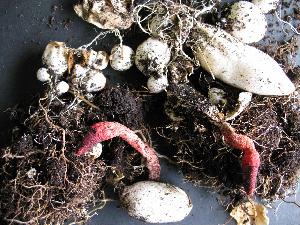
Mutinus elegans was sequenced as part of the
From Wikipedia
Mutinus elegans, commonly known as the elegant stinkhorn, the dog stinkhorn, the headless stinkhorn, or the devil's dipstick, is a species of fungus in the Phallaceae family. A saprobic species, it is typically found growing on the ground singly or in small groups on woody debris or leaf litter, during summer and autumn in Japan, Europe, and eastern North America. The fruit body begins its development in an "egg" form, resembling somewhat a puffball partially submerged in the ground. As the fungus matures, a slender orange to pink colored stalk emerges that tapers evenly to a pointed tip. The stalk is covered with a foul-smelling slimy green spore mass on the upper third of its length. Flies and other insects feed upon the slime which contains the spores, assisting in their dispersal. Due to their repellent odor, mature specimens are not generally considered edible, although there are reports of the immature "eggs" being consumed. In the laboratory, Mutinus elegans has been shown to inhibit the growth of several microorganisms that can be pathogenic to humans.
